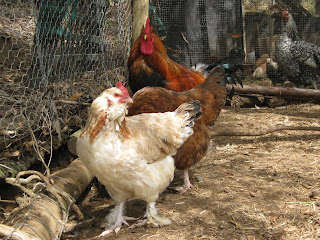
Howdy all
It's time to unleash my thoughts and practical developments concerning the design and use of the backyard wood bbq upon my grander audience.
So briefly:
Wood bbq's are the best. You smell the bush and celebrate the great outdoors
Below is what works for me for:
- minimal / efficient fuel use,
- cooking space for 20 in one go
- cheap and easy to construct , even take away
Special equip.: use a piece of roughly 2cm hole size steel mesh cut to oversize shape with bolt cutters (small ones will do it) or angle grinder (mesh is about $24 I think for 2.4 by 1.2 metre size from Metalcorp in Nth Geelong. It's useful stuff for greenhouse shelves, etc, anyway.
The pic below is an earlier version where I placed it over a half dug fire pit.
I say don't make a fire pit (digging) . Do it at ground level.... make a horseshoe shape with bricks or rocks on sides and back with lots of airhole spaces all around. I haven't tried it, but on a less windy day even just supporting the corners may work, although I think smoke and irest heat may be more of a problem Aim to get the mesh about 20 or 30cm above ground, 10 to 20 above the coals.
Get your fire going and hot with max size big wood 10 cm diam. Recommend in pref order: hard wattles (black wattle, golden wattle), she oaks (casuarina), melaluccas, then eucs (great variety in how they burn). But all should be dried for a least a year.
Also, one can use dried fruit tree prunings which the smoke from will be vaguely fragrant of the fruit
Once flames subdue, smoke minimal, but hot, whack on the mesh and get cooking. Long tongs. oversize mesh cool on edges gives you holding place.
Watch out for real windy days when dust and dirt can get on to food easier when closer to the ground.
Because you've got heaps of space and pure heat over a big surface area of the food it's great for cooking stuff like eggplants, mushies, capsicum, tomatoes, kale leafs, chicken wings, sausages,
You can also early on put on a frying pan for sautéing onions while the flames are high, along with a billy for drinks later,
You can cook stuff in foil or clay in the coals underneath like potatoes or bananas for sweets. Marshmallows on sticks for kids treat
If you have a tin pizza tray and a rough lid cover, you can cook a really crisp, toasty pizza in about 15 mins c/f 3hrs plus and half a ton of wood for a pizza oven to get ready.
Very handy also to have a higher fold up table (eg card tale) for wine, keeping food out of reach of dogs, cutlery and plates, etc..
Good luck, hope this might be of use.
CU
